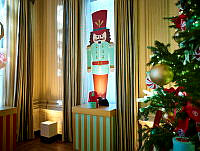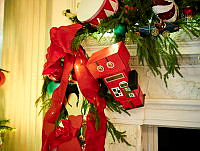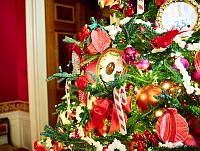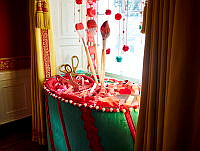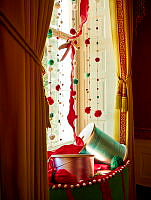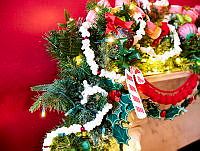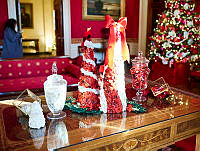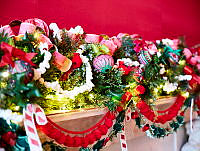Rubenstein Center Scholarship
Girl Scouts and First Lady Lou Hoover
Girl Scouts have been connected to the White House for almost as long as they have existed. Juliette Gordon Low founded Girl Scouts of the USA in 1912. Low came from a prominent southern family and lived abroad for many years in England, where she first encountered the scouting movement.1 After befriending Robert Baden-Powell, author of the book Scouting for Boys and founder of Boy Scouts, she made it her mission to bring scouting to American girls.2 Girl Scouts was dedicated to teaching skills that helped girls better serve their communities, their households, and their country. Back in the United States, Low moved freely between social and political circles to grow her organization.3 The first Girl Scout troop was formed in Savannah, Georgia, Low’s hometown. However, the headquarters for the national organization was in Washington, D.C., where Low recruited prominent women to serve on the first board of directors.4 By 1917, Girl Scouts boasted over seven thousand members nationwide and was already a fixture among women’s organizations. Girl Scouts even marched in President Woodrow Wilson’s 1917 Inaugural Parade, the first time women participated in the official inaugural procession.5
Because Girl Scouts was an organization for young women and had ties to the D.C. social scene, as well as the fact that presidents had been involved with Boy Scouts, it made sense to recruit the first lady. On June 21, 1917, Girl Scouts invited First Lady Edith Bolling Wilson to attend their annual convention and present a young scout with the Golden Eaglet, the organization’s highest honor at the time.6 This started a long tradition of first ladies fulfilling a ceremonial role in the organization. Later that year, Juliette Low asked the first lady to serve as the honorary president of the national organization.7 In thanks for her service, Low presented her with a Cartier “thanks badge,” which had a trefoil design featuring diamonds, emeralds, and a ruby in the center.8 Every first lady since has held the position of honorary president of Girl Scouts. Though it began as a ceremonial position, many first ladies have taken it in stride and become substantive leaders within the organization.

First Lady Edith Bolling Wilson’s Thanks Badge
Image courtesy of Girl Scouts of the USAFirst Lady Lou Henry Hoover was deeply involved with Girl Scouts even before she entered the White House. Hoover served on the first board of directors when Girl Scouts was incorporated in 1915.9 The following year, Juliette Low moved the national headquarters from Washington, D.C. to New York City and asked Hoover to run the local Girl Scout Council in D.C.10 In 1917, Girl Scouts elected her as vice president of the national organization, and then president in 1922.11 During her tenure as president, she expanded the organization by recruiting girls and disseminating a positive public image for Girl Scouts, most notably by overseeing the publication of The American Girl, the organization’s monthly magazine.
In 1925, Hoover resigned as the national president so that she could assume the role of executive board chair. In this capacity, she improved the Girl Scouts’ business strategy and established standardized bylaws and charting systems.12 She also encouraged her friend, First Lady Grace Coolidge, to engage with Girl Scouts.13 For instance, Hoover wrote a profile of Coolidge in a 1926 issue of The American Girl.14 On a smaller scale, she led a troop of her own, Washington Troop #8, which she maintained even after entering the White House in 1929.15 Girl Scouts espoused many of Lou Hoover’s values. She stated “there are three fundamental goods in it. It teaches play, individual helpfulness, and citizenship.”16
Like Juliette Low, Lou Hoover was extremely influential in D.C., and she used her connections to grow Girl Scouts. One such example of her influence was the Girl Scouts’ Little House. During the month of June 1923, the General Federation of Women’s Clubs collaborated with the Better Homes in America movement to build a small functional model home on the National Mall. Led by then Secretary of Commerce Herbert Hoover, Better Homes demonstrated how a well-functioning house could improve the lives of the average American family.17 When the demonstration ended, Lou Hoover convinced the General Federation of Women’s Clubs to donate the house to Girl Scouts. She then personally financed moving the house to the corner of Eighteenth Street and New York Avenue, just a few blocks from the White House.18 She was involved throughout the whole process, right down to securing contracts and permits.19 On March 24, 1924, after the house moved from the Mall, Hoover presided over the rededication ceremony as First Lady Grace Coolidge laid the cornerstone.20

Workers move the Little House from the Ellipse to its eventual location on New York Avenue.
Library of CongressIn the following decades, Girl Scouts used the Little House to meet and learn to manage a home. A pamphlet published by Girl Scouts in 1931 called it an “indoor laboratory for homemaking.”21 Several first ladies visited the house, where girls demonstrated their homemaking skills by serving tea or lunch, or by gardening with them.22 Each year, Girl Scouts celebrated Better Homes Week, where they invited the public into the house to observe their work. In 1930, Hoover, now serving as first lady, commissioned a scale model of the Little House so that it could travel the country and inspire local councils to create their own little houses. That same year, she presented the model at the Girl Scouts’ annual national convention in Indianapolis, Indiana, as she hoped that it would promote the building of more little houses across the country.23 It did inspire other councils, and Girl Scout Little Houses popped up all over the United States. Lou Hoover even commissioned a similar little house to be built for scouts in her hometown of Palo Alto, California. Some little houses still exist today.24 D.C. girl scouts used the Little House on New York Avenue until 1955.25

Grace Coolidge lays the cornerstone for the Girl Scouts’ Little House while Lou Hoover looks on.
Library of CongressEven after Lou Hoover became the first lady in 1929 and moved into the honorary position of president, her commitment to the organization never wavered. At the national convention that year, she announced a five-year plan to increase membership and make the organization financially self-supporting.26 She also secured a $500,000 donation from the American Relief Administration, an agency that Herbert Hoover had run following the first World War.27 During her time in the White House, Lou Hoover involved girl scouts in many of her hostess duties. For example, in 1929, the Hoovers hosted British Prime Minister Ramsay MacDonald, and the first lady invited a group of Girl Scouts to welcome his daughter Ishbel on the South Lawn.28 The scouts prepared a program of games and performances to show Ishbel what it was like to be an American girl.29

Ishbel Macdonald with Lou Hoover and girl scouts in front of the White House.
Library of CongressMoreover, Lou Hoover’s leadership from the White House was vital in helping the Scouts stay afloat during the Great Depression. In 1931, she invited the Girl Scouts Executive Council to Camp Rapidan, a presidential retreat and precursor to Camp David, and encouraged them to shift the mission of the organization to volunteerism and to focus on homemaking skills that were more economical.30 Soon after, she unveiled what became known as the Rapidan Plan at the annual national convention. The plan included initiatives to keep kids in school, lessons on being resourceful, and other ways girls could help their individual communities. Hoover used the power of the White House to publicize the Rapidan Plan and gave a national radio address alongside two young Girl Scouts where she encouraged girls to help families struggling with unemployment.31 This signaled a shift in Girl Scouts’ mission as it then became known as a charity organization rather than a social club.32 Additionally, enrollment in Girl Scouts increased over the course of the 1930s despite the lingering effects of the Great Depression.33
When President Hoover left office in 1933 and Mrs. Hoover was no longer first lady, she jumped right back into her leadership of the Girl Scouts. Hoover once again joined the national board of directors in 1933, and then became national president for a second time in 1935. She oversaw continued expansion of the organization, including revolutionizing Girl Scout Cookie sales by recruiting commercial bakers to make them and nationalizing the program.34
The legacy of Lou Hoover and Girls Scouts’ influence in the White House continued with each subsequent first lady. Her successor, First Lady Eleanor Roosevelt, willingly became honorary national president, despite her contentious relationship with Hoover. In a letter from 1933, Board Chairman Genevieve Brady wrote to Hoover, “It is to be my painful duty to go to Mrs. Roosevelt about being the honorary chairman. You know our personal feelings do enter into things in spite of trying to think just of our organization.”35 Still, Hoover insisted that Roosevelt participate in Better Homes Week in 1933 so as not to shirk tradition. In a letter about invited guests to the Little House, Hoover wrote, “It would be a pity to have the Girl Scouts have breaches of manners!”36 Eleanor Roosevelt did, in fact, attend the celebration at the Little House, and she continued to participate in Better Homes Week for the rest of her tenure.37 During Better Homes week in 1938, Roosevelt planted a tree from Hyde Park in the garden of the Little House.38 She continued to participate in scout ceremonies, and celebrated Girl Scouts’ twenty-fifth birthday alongside Lou Hoover.39

Eleanor Roosevelt and Lou Hoover at the Girl Scouts twenty-fifth anniversary celebration.
Image courtesy of Girl Scouts of the USAWhen Lou Hoover’s term as national president ended in 1937, she decided it was best to step down from her leadership position. Twenty-five years after its founding, many of the women who formed the organization were no longer leading it. Juliette Low died in 1927, and Hoover’s close friend Abbie Rickard, whom she had recruited into Girl Scouts in the first place, had already stepped away from the organization after falling ill in 1935.40 Hoover decided to pass the torch to the next generation of Girl Scouts and Girl Scout leaders. When she died on January 7, 1944, around 200 Girl Scouts joined mourners at her funeral.41 Shortly after, the organization released a pamphlet with a tribute to her written by her former White House Secretary Dare Stark McMullin. She wrote about Hoover: “from 1917 to the very end of her life, Girl Scouting was one of her great enthusiasms and she devoted herself to it heart and soul.”42 To this day, girl scout councils across the country still have Lou Henry Hoover memorial patches that girls can earn by exploring and preserving wildlife, a tribute to her love of camping and geology.43

Lou Hoover in uniform
Image courtesy of Girl Scouts of the USABeginning with Edith Wilson in 1917, every successive first lady has been named honorary president of the Girl Scouts. While some were more active than others in the role, first ladies have continued to perform their ceremonial duties and maintain traditions. For example, first ladies often attend Girl Scout conventions and participate in annual cookies sales. Each first lady has filled the role differently, but their dedication to Girl Scouts has remained consistent over the past century.
Gallery
-

Eleanor Roosevelt plants a tree at the Little House for Better Homes Week.
Library of Congress -

Bess Truman opens the 1950 cookie season as two scouts give her the first box.
Image courtesy of Girl Scouts of the USA -

Mamie Eisenhower accepts cookies from her nieces in 1953.
Image courtesy of Girl Scouts of the USA -

Lady Bird Johnson receives two Girl Scouts as a portrait of Lou Hoover hangs in the background.
Image courtesy of Girl Scouts of the USA -

Betty Ford attends 40th national convention for Girl Scouts of America.
National Archives and Records Administration -

Rosalynn Carter stands with Girl Scouts and the president and executive director of the national organization.
Image courtesy of Girl Scouts of the USA -

Nancy Reagan makes the girl scout promise as she is invested as honorary national president.
Image courtesy of Girl Scouts of the USA -

Barbara Bush attends the 80th anniversary celebration, where she was also the keynote speaker.
Image courtesy of Girl Scouts of the USA




















































